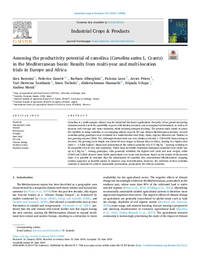Assessing the productivity potential of camelina (Camelina sativa L. Crantz) in the Mediterranean basin: Results from multi-year and multi-location trials in Europe and Africa

Authors:
Camelina is a multi-purpose oilseed crop for industrial bio-based applications. Recently, it has gained increasing attention mostly due to the possibility to grow with limited resources and in marginal environments, as well as to increase soil coverage and water retention, while reducing nitrogen leaching. The present study aimed to assess the viability of using camelina as an emerging oilseed crop for EU and African Mediterranean farmers. Several camelina spring genotypes were evaluated in a multi-location trial (Italy, Spain, Algeria, Morocco and Tunisia) in two growing seasons (2020–22). Although thermal time was very similar at all sites (∼1300 GDD from sowing to harvest), the growing cycle length was about 60 days longer in Europe than in Africa, leading to a higher seed yield (∼ 1.5-fold higher). Mean seed production in the African countries was 0.71 Mg ha−1 proving camelina to be adaptable even to very arid conditions. Under more favorable conditions (European countries) seed yields was up to 2 Mg ha−1. Among genotypes, Alba generally exhibited the highest seed yield and seed weight, while CCE42 and CCE29 showed more stable productions over years and locations. Based on the results of the present study it is possible to conclude that the introduction of camelina into conventional Mediterranean cropping systems appeared as feasible option to improve crop diversification; however, the selection of best camelina varieties is essential to achieve sustainable productions, particularly for African countries.
